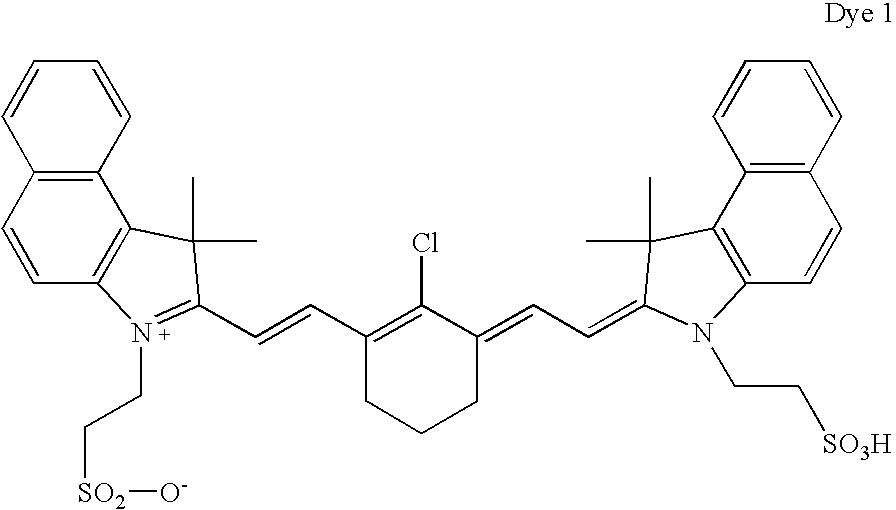Negative-working thermal lithographic printing plate precursor comprising a smooth aluminum support
a technology of thermal lithographic printing plate and aluminum support, which is applied in the direction of plate printing, foil printing, duplication/marking methods, etc., can solve the problems of generating debris which is difficult to remove, no prior art material, which works, etc., and achieves the effect of reducing image wear, high run length and high run length
- Summary
- Abstract
- Description
- Claims
- Application Information
AI Technical Summary
Benefits of technology
Problems solved by technology
Method used
Image
Examples
example 1 (comparative)
and 2 (Invention)
Preparation of the Lithographic Support 1
[0031]A 0.30 mm thick aluminum foil was degreased by immersing the foil in an aqueous solution containing 40 g / l of sodium hydroxide at 60° C. for 8 seconds and rinsed with demineralized water for 2 seconds. The foil was then electrochemically grained during 15 seconds using an alternating current in an aqueous solution containing 12 g / l of hydrochloric acid and 38 g / l of aluminum sulfate (18-hydrate) at a temperature of 33° C. and a current density of 130 A / dm2. After rinsing with demineralized water for 2 seconds, the aluminum foil was then desmutted by etching with an aqueous solution containing 155 g / l of sulfuric acid at 70° C. for 4 seconds and rinsed with demineralized water at 25° C. for 2 seconds. The foil was subsequently subjected to anodic oxidation during 13 seconds in an aqueous solution containing 155 g / l of sulfuric acid at a temperature of 45° C. and a current density of 22 A / dm2, then washed with demineraliz...
example 3 (
Invention) and 4 (Comparative)
Preparation of the Lithographic Support 3
[0038]A continuous web of aluminum having a thickness of 0.30 mm and a width of 500 mm was degreased by immersing the web in an aqueous solution containing 10.4 g / l of sodium hydroxide at 38° C. for 35 seconds and then rinsing with demineralized water for 30 seconds. The aluminum web was then electrochemically grained for 30 seconds using an alternating current at a current density of 826 A / m2 in a mixed acid aqueous solution containing 9.5 g / l of hydrochloric acid and 21 g / l of acetic acid at a temperature of 29° C. The support thus obtained had an average center-line roughness Ra of 0.24 μm. After rinsing with demineralized water for 30 seconds, the aluminum web was etched to remove smut with an aqueous solution containing 124 g / l of phosphoric acid at 43° C. for 35 seconds and then rinsed with demineralized water for 30 seconds. The aluminum web was subsequently subjected to anodic oxidation for 30 seconds in ...
examples 5-9
Preparation of Lithographic Supports 5-9
[0042]A continuous web of aluminum having a thickness of 0.30 mm and a width of 500 mm was degreased by immersing the web in an aqueous solution containing 10 g / l of sodium hydroxide at 39° C. for 35 seconds and then rinsing with demineralized water for 30 seconds. The aluminum web was then electrochemically grained for 30 seconds using an alternating current at a current density as indicated in Table 1 in a mixed acid aqueous solution containing 8.1 g / l of hydrochloric acid and 21.7 g / l of acetic acid at a temperature of 30° C. After rinsing with demineralized water for 30 seconds, the aluminum web was etched to remove smut with an aqueous solution containing 128 g / l of phosphoric acid at 43° C. for 35 seconds and then rinsed with demineralized water for 30 seconds. The aluminum web was subsequently subjected to anodic oxidation for 30 seconds in an aqueous solution containing 154 g / l of sulfuric acid at a temperature of 50° C., using a DC vo...
PUM
| Property | Measurement | Unit |
|---|---|---|
| surface roughness | aaaaa | aaaaa |
| surface roughness | aaaaa | aaaaa |
| surface roughness | aaaaa | aaaaa |
Abstract
Description
Claims
Application Information
 Login to View More
Login to View More - R&D
- Intellectual Property
- Life Sciences
- Materials
- Tech Scout
- Unparalleled Data Quality
- Higher Quality Content
- 60% Fewer Hallucinations
Browse by: Latest US Patents, China's latest patents, Technical Efficacy Thesaurus, Application Domain, Technology Topic, Popular Technical Reports.
© 2025 PatSnap. All rights reserved.Legal|Privacy policy|Modern Slavery Act Transparency Statement|Sitemap|About US| Contact US: help@patsnap.com

